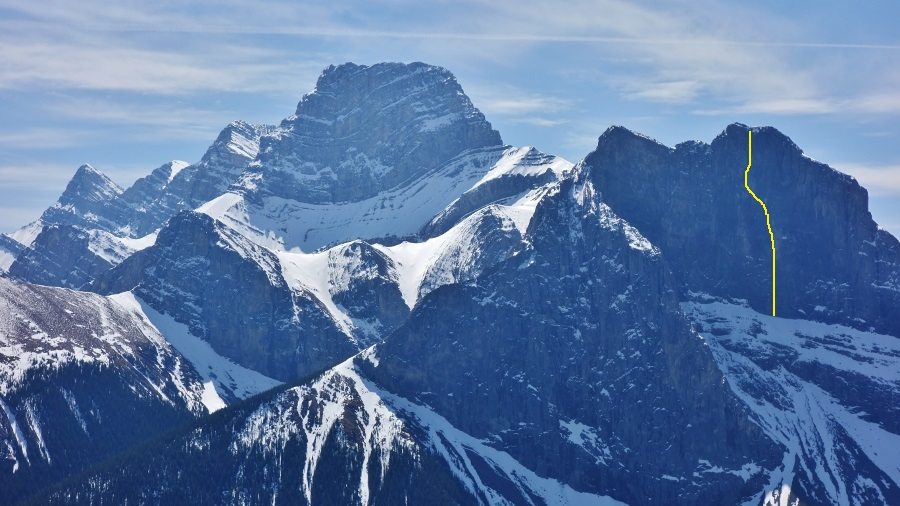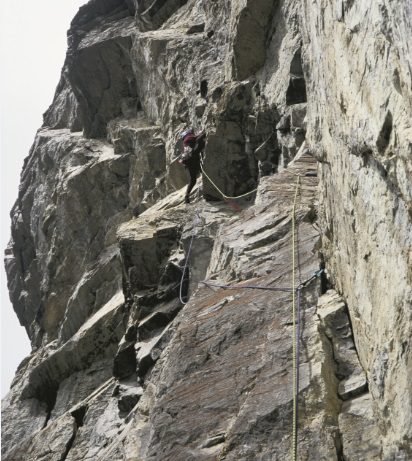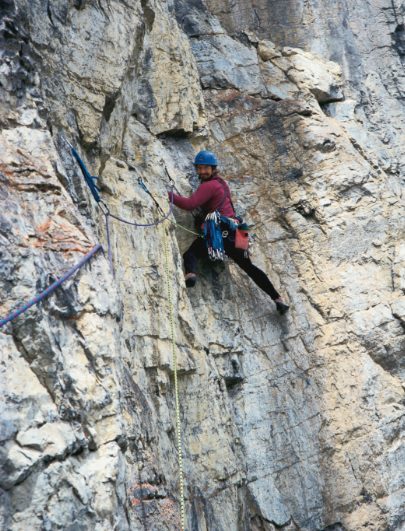Jeff Marshall has shared a letter through a friend on Facebook that details his thoughts about altering existing routes.
Who is Jeff Marshall? In case you had never heard of him, he’s one of the first climbers to push hard routes up big rock and ice lines in the Canadian Rockies.
Often done with partner Steve DeMaio, Marshall pushed the boundaries of what climbers thought possible on the big and black limestone walls around the Bow Valley.
In the below letter, Marshall makes note of two of his routes, the unrepeated 450-metre The Iron Butterfly 5.11+ A4 on the Windtower and Jimmy and the Kid on Yamnuska, which was a bold A3+ pitch now goes at 5.12b on gear.
The main takeaway from Marshall’s letter is that he thinks replacing old hardware on pitches and at belays should absolutely be done, but new fixed protection should not be added.
It was originally posted in the Bow Valley Climbing Crew by Vagus Urbe.

Jeff Marshall’s Food for Thought
I think it’s about time that I add in my two cents about altering existing routes.
Firstly – I’ve done it. Secondly – don’t. Just don’t. I have also been responsible for moving a few belays. Why? Well, I suppose I felt that because I was one of the big guys back then, standing at 5’4″, I could do things like that. I, like a few others, thought I was making the routes better. I still think they are, but that is not the point here. The point is that I altered somebody else’s route to fit my own personal tastes. This entire business of rearranging routes, whatever the justification, is wrong – period. So, I have done my part to undermine my predecessors. For that I am so, so sorry – to them and to all that have followed. I really hate hypocrisy. A little self-reflection at times gives one insightful clarity to realize that one is not above being a hypocrite oneself. Thankfully, humanity has the capacity to reflect and improve.
When I was a youngster out at Wasootch one day, I might have drilled the first rap-placed bolt in the Canadian Rockies. If anybody would like to challenge that claim, feel free. It is not particularly important to me. Wasootch was/is a practice area where most climbs were/are top-roped. I thought, why not put a bolt in and then lead the dern thang? It made sense to me at the time and still does. As I was hand-drilling, the entire Edmonton section of the ACC was giving me an ear-full and then some.
When I was still very young and innocent, Barry Blanchard took a dive attempting the route Paper Chase. He pulled his piece and ended up almost hanging himself. So I went up a week or so later and tapped a bolt in, thinking that in order to advance we needed safe climbs to train on. Big mistake. I endured years of very well-deserved tongue lashings. There were a few times where the verbal almost turned into the physical. The irony of all this is that Marshall, the stalwart traditionalist, was possibly the first to think of sport climbing in the Rockies. Again, if somebody cares to challenge this, it’s all yours. Not important to me.
In the spring of ’85, my partner and I arrived back in Calgary from a trip up north and found ourselves in Grotto Canyon, where sport climbing had officially been launched. I thought at the time that it was fun. Not very inspiring, but still fun. Kinda like an outdoor gymnasium. I had no idea at the time that this new thing and I would end up locking horns, and it would put a serious wedge in the community for a few years.
In the mid- to late eighties, there was a virtual war between old school and new school, and I always seemed to take the brunt of it from the new climbers. I have been referred to as one of the main outspoken advocates of the old school. I still have a very deep passion for the pure traditionalist approach and would really like to see it preserved. That approach, put simply, is that you start at ground zero and climb to the top without any additives such as power, or top-down tactics, or whatever the hell people have come up with. I don’t understand rap-bolting or carrying a power drill to champion big routes. I know, faster and safer. Still don’t get it. I’ve always felt that big routes require some serious battling and there are no guarantees. It makes the game much more interesting.
Moving forward in time. Probably fairly common knowledge that in 2000, I had a little psychological setback that preoccupied my time for the better part of too many years. During that time I was along for two retro-fits of established routes: Mantissa in the Ghost River (which had already been altered by another party) and Excalibur on Yamnuska. Unfortunately, both of these routes are now lost. They are different climbs now. Might as well rename them. Or make a much better choice and go restore them. Please. If not already done by the time I heal from a few injuries, then I guess I’m going to be pulled back into the ring again. That said, I would rather not. I really am getting too old for this shit.
On both of those excursions, I was unbelievably frightened and had no right being there. Climbing? Hell, I was afraid of my own shadow. Let’s just say that my lead couldn’t keep the ropes tight enough. I had also completely lost any sense of identity. My judgement was at best, substandard. My courage – vanished. These are not excuses. They’re a fact.
So here I am now, a ways down the road. Nicely grounded, developing focus, and keen again.
Firstly, trust me, I either know of or have participated in countless ethical climbing debates – ad nauseum. So let’s keep it simple. Once a route has been established, it’s done. It doesn’t matter whether the first ascencionists decided to drill a silver ladder or run things out. That’s their business. One way or another, you will be met with either criticism or approval. Part of the game. Every route has a unique and personal signature. And that signature tells a story about a climber at that particular time in his or her life. And lucky you, you get to experience it decades later the same way they did. Wow! I’m facing the same shit that Brian Greenwood did 50 years ago, and oh my God, he was a very serious dude. Pretty darn cool if you ask me.
Now here’s the kicker. As climbers age, they change. When you get older you have different priorities. As we age, we forget the fire and passion we felt at the time. We become different people. Sometimes very different. So when somebody asks for permission to “fix up an existing route”, they might as well get it from a drunken sailor, or their dentist, or the rare Alberta hillbilly. Because they are not actually getting it from the same person. Make no mistake, the route’s author is a changed individual. If you had asked for permission to change the route directly after they did it, you’d have been told where to go and just how fast to get there.

The one thing I really don’t understand is why change a route in the first place? The only reason I can see, with the plethora of climbs out there, is that you want to say that you climbed said route but didn’t want to pay the price of admission. If this is you, you have not nor ever will climb that route. Traditional climbing in our mountains, more often than not, threatens one’s mortal existence. THAT’S WHAT MAKES IT DIFFERENT. If a route is intimidating for whatever reason, then either grow to become a challenger, or leave it for somebody else. Doesn’t mean you don’t measure up, it’s just not your cup of tea. Nothing wrong with that. One thing I will say is that old school takes much longer to master and, in my humble opinion, is a much more rewarding road to travel.
The point of this exercise is to try and preserve our past and give future climbers the chance to drink from the same wonderfully intoxicating cup as we did. Facing the possibility of meeting one’s maker if you blow it, but then succeeding, I guarantee, will be one of the best memories of your life. The original crux pitch of Excaliber was a no falls affair that has been described as a suicide pitch.
Well, that’s a fair statement because it is/was. I want to leave my mark for others to contemplate. I liked being out there where things get pretty darn real at times and so I want to offer that same experience to future generations. You cannot have that experience with additional bolts in place that you choose not to clip, because if things do go south when you’re in the thick of things, you can still opt out and bail. That’s pretty harsh but that’s just the way it is.
Sport, gym, bouldering – these are all about strength and style. Trad – or at least old-school trad – is all about courage and commitment. The key to the former lies in one’s fingers and forearms. The key to the latter lies deep in one’s cranium. The former is, or at least should be, safe. The other might cost you your life. Your choice. It’s a free country, brotha. Believe it or not, future generations are going to produce climbers that need frightening routes to hone their minds on and then go on to lay down their own modern Rocky Horror test-pieces. And yes, some will pay with their lives. These climbers know the score and consciously go looking for it. It’s commonly referred to as progression.
In the latest Yam guide, Steve and my route Quantum Leap apparently has seen the addition of some fixed pins. Andy, who is a very good friend of mine (and hopefully remains so), has said “please leave them be.” Well, I say get rid of the goddamn things and I’ll tell you why. It’s adding fixed gear to an established route, undoubtedly for the benefit of the next party. A nice thought and very considerate. I may ruffle a few feathers by saying this, but screw the next team. They should have to deal with the same stuff that we did.
Who in their right mind realistically trusts fixed pins anyway? I don’t. So what I’ve done over the years is slide in a bolt close to the odd old fixed pin. Seems fair enough. It’s a fixed piece after all. The question is, was that pin left behind during the first ascent? If you’re starting to see how insidious this can be, then you can appreciate my concern. There was nothing there before, and now there is – whether a fixed pin or a bolt. If anybody can tell me the difference between the two, I’m all ears.
With regards to some of our climbs, some of the hangers did get removed – mostly for financial reasons. I’m not sure why the cap screws have gone missing. Steve was living on fumes and so I guess I should have just bit the bullet and funded the whole bloody affair instead of a fair amount of it. What has basically transpired is that a few routes are missing some very essential bolts. Without that gear, these climbs would take a far better and far more serious team than we were. In a sense, it’s kinda like rehearsing the shit out of a new sport climb on top rope, and then protecting it like a solo. I know, because I had the pleasure of hanging on to the crux pitch of Steve’s Jimmy and the Cruisers during the second ascent, and replacing all of the missing hangers. Fun? Not really.
I believe the only two routes left from Steve and me that have not been repeated are Jimmy and the Kid on Yam – which is only missing one bolt a short distance up pitch 4, and The Iron Butterfly on Windtower. It’s okay to replace the old or missing bolts on these two routes, but please do not add any extras. Just like all of the other routes done by your predecessors. Our routes were not put up for the masses. They just ended up being difficult and dangerous, at least for us. I remember saying to Steve once, “I would not want to be the future talent who is going to up the ante.” I’m just as happy if the missing bolt on Jimmy and the Kid is a nice big fat one by the way.
Our route on Windtower defines Rockies extreme. It was the maximum in every sense of the word. I really would like to see a repeat sometime. The Iron Butterfly was an epic battle for us and so it is absolutely imperative that it does not fall victim to technology. There is a ton of wide open space to make your mark out there, so there is really no need to lower the bar on any of the old routes. If a competent party tries our route and finds some hangers missing, they should feel free to replace them and all of the anchors. But if the heat gets to be too much, just leave it and go find something else to do.
My last point is about anchors. One of my biggest concerns in climbing is taking out the belay with a factor-two fall. I’ve been responsible for testing a few anchors and I’ve also had a few tested for me. Factor-two falls are unbelievably violent. The force experienced by the belayer is horrendous. The belay must stick. There is just no good reason for the team to perish because the lead comes up short. So for me, bolting belays gets two thumbs up. In my opinion, there is no debate on this issue. There are actually some really good reasons why I’m still here, and luck is the least of them.
The outdoors is like modern consumption, people. Please enjoy responsibly.

